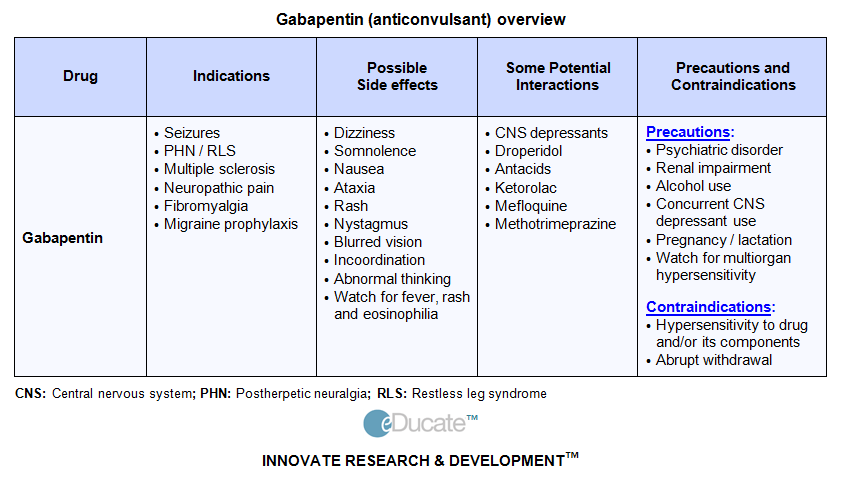Studies have also found the drug to have a substantial analgesic effects on diabetic neuropathy, postherpetic neuralgia, migraine, and other neuropathic pain conditions, as well as beneficial effect on sleep and restless legs syndrome. On the basis of these findings, the researchers suspected that gabapentin might also ease fibromyalgia pain.
For treating the chronic pain and other symptoms of fibromyalgia, the anticonvulsant gabapentin (Neurontin) proved safe and effective, researchers here reported.
In a 12-week randomized, double-blind clinical trial, patients taking gabapentin displayed significantly less pain, better sleep, and less fatigue than placebo controls, Lesley M. Arnold, M.D., of the University of Cincinnati, and colleagues reported in the April issue of Arthritis and Rheumatism.
However, the drug had no effect on acute pain points or depression, the researchers reported.
Although gabapentin, which was used off-label for fibromyalgia, has little, if any, effect on acute pain, it has shown a robust effect on pain caused by a heightened response to stimuli related to inflammation or nerve injury in animal models of chronic pain syndromes, Dr. Arnold said.
Studies have also found the drug to have a substantial analgesic effects on diabetic neuropathy, postherpetic neuralgia, migraine, and other neuropathic pain conditions, as well as beneficial effect on sleep and restless legs syndrome. On the basis of these findings, the researchers suspected that gabapentin might also ease fibromyalgia pain.
The study, supported by the National Institute of Arthritis and Musculoskeletal and Skin Diseases, included 150 mainly white fibromyalgia patients (90% women). Of these, 75 took gabapentin at dosages of 1,200 to 2,400 mg daily for 12 weeks, while there were 75 placebo controls.
The study was conducted at three outpatient research centers in the U.S., from September 2003 to January 2006.
The mean pain severity scores, measured by the Brief Pain Inventory (BPI), decreased in both groups but more so among the gabapentin patients (P = 0.015). The estimated difference between groups at week 12 was – 0.92 (95% confidence interval -1.75, -0.71).
Of the gabapentin-treated patients, 51% achieved a response at the endpoint compared with 31% of the placebo patients (P=0.014).
 Gabapentin compared with placebo also significantly improved the BPI average pain interference score, as well as a series of other scores. These included the Fibromyalgia Impact Questionnaire total score, the Clinical Global Impression of Severity Improvement, the Patient Global Impression of Improvement, the Medical Outcomes Study (MOS), the Sleep Problems Index, and the MOS Short Form 36 vitality score.
Gabapentin compared with placebo also significantly improved the BPI average pain interference score, as well as a series of other scores. These included the Fibromyalgia Impact Questionnaire total score, the Clinical Global Impression of Severity Improvement, the Patient Global Impression of Improvement, the Medical Outcomes Study (MOS), the Sleep Problems Index, and the MOS Short Form 36 vitality score.
However, the drug had no effect on acute pressure-point pain or depression (the Montgomery Asberg Depression Rating Scale), the researchers reported.
Overall, the drug was well-tolerated. Of the 150 patients, 19 dropped out due to adverse events, with no significant difference between the treatment groups.
The gabapentin patients reported dizziness, sedation, lightheadedness, and weight gain significantly more often that did the placebo-treated patients. Notably, the researchers said, there was no significant difference in weight change in the two groups as measured in the clinic, although edema may have explained some of the patients’ perceptions. Most treatment adverse events, they reported, were mild to moderate in severity.
The pathophysiology of fibromyagia is unknown, but evidence suggests that it is associated with aberrant central nervous system pain processing, the researchers said.
The drug appears to be effective in reducing abnormal hypersensitivity induced by inflammatory responses or nerve injury. Yet unlike many other pain syndromes, there is no physical evidence of inflammation or CNS damage.
One possible explanation, Dr. Arnold said, is that gabapentin’s effects involve binding to a specific subunit of voltage-gated calcium channels on neurons. This binding, she said, reduces calcium flow into the nerve cell, which reduces the release of some signaling molecules involved in pain processing.
In discussing the study’s limitations, the researchers said that because the study was short, the results may not generalize to longer treatment periods, and long-term efficacy should be studied in future clinical trials.
Also, because the study was relatively small, they said it may have lacked the power to detect potentially relevant differences between the groups. Finally, they wrote that the results may not apply to patients with some comorbid psychiatric disorders, such as bipolar disorder, or to patients with other painful musculoskeletal disorders.
“In this, the first randomized, placebo-controlled study to evaluate gabapentin in the treatment of fibromyalgia, the results demonstrated that gabapentin, taken for up to 12 weeks, is effective and safe in the treatment of pain and other symptoms associated with fibromyalgia,” Dr. Arnold concluded.
Gabapentin may be useful in the treatment of comorbid anxiety in bipolar patients, (however not the bipolar state itself). Gabapentin may be effective in acquired pendular nystagmus and infantile nystagmus, (but not periodic alternating nystagmus). It is effective in hot flashes. It may be effective in reducing pain and spasticity in multiple sclerosis. Gabapentin may reduce symptoms of alcohol withdrawal (but it does not prevent the associated seizures). Use for smoking cessation has had mixed results. Gabapentin is effective in alleviating itching in renal failure (uremic pruritus) and itching of other etiologies. It is well-established in the treatment of restless leg syndrome. (A prodrug form, gabapentin enacarbil, is also effective.) Gabapentin is effective in insomnia.
Primary Source
Arthritis and Rheumatism
Source Reference: Arnold LM, et al”Gabapentin in the Treatment of Fibromyalgia: A Randomized, Double-Blind, Placebo-Controlled, Multicenter Trial”Arthritis Rheum 2007; 56: 1336-1344.
https://en.wikipedia.org/wiki/Gabapentin